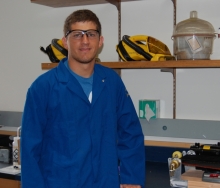
Major:
University:
Mentor(s):
Faculty Sponsor(s):
Faculty Sponsor's Department(s):
Project Title:
Project Description:
With increasing use of semiconducting polymers in modern electronics, it is essential to improve the charge transport of these materials. The degree of crystallinity and polymer chain alignment are two properties that can help to improve the charge transport of semiconducting polymers. Poly(3-(2’-ethyl)hexylthiophene (P3EHT) is a semiconducting polymer that has relatively low charge transport; thus, our project goal is to increase the charge transport of P3EHT by increasing the alignment of the polymer chains. Mechanical rubbing of the P3EHT polymer films is believed to induce alignment of the surface polymer chains, so we have constructed an apparatus that will rub the P3EHT polymer films at different rates and pressures using a velvet cloth. The shear stress and local heating due to friction are believed to be the factors that cause the polymer chains to align. To determine the degree of alignment, we used atomic force microscopy to image the polymer films before and after the rubbing treatment. Additionally, UV-Vis spectroscopy helped us to determine the dichroic ratio before and after the rubbing treatment. We compare the results of rubbing P3EHT with comparable treatments on a range of conjugated polymer with varying persistence lengths (P3HT, PBTTT, DEH-PPV) and find that the efficacy of rubbing increases dramatically with stiffer backbones. The greatest dichroic ratio we found for P3EHT was 1.09 when we rubbed the polymer at 49,000 dynes/cm2. The greatest dichroic ratios we found for P3HT, PPV, and PBTTT were 1.70, 2.64, and 1.88, respectively. This supports our hypothesis that a more rigid polymer backbone allows for better alignment when rubbing techniques are employed. Now that we have successfully aligned the polymer chains, we would like to see if we can induce alignment throughout the entire film via melt recrystallization. When this is successful we will test the charge transport before and after the polymer films have been rubbed. Follow-up work will investigate alternative methods for aligning this family of short persistence length polythiophenes for follow up studies of link between chain alignment and charge transport.
